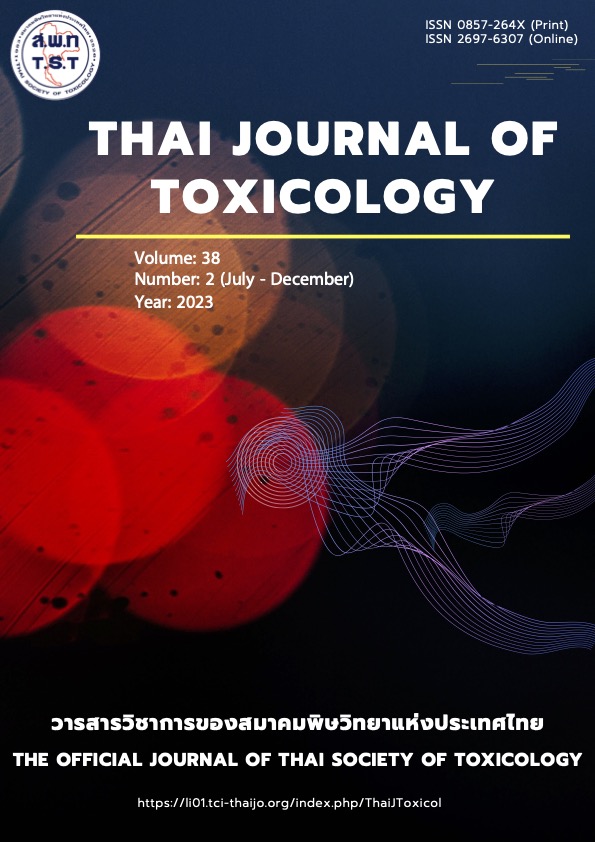Acute Oral Toxicity Testing of Thai Traditional Medicine “Ya-Kae-Lom-Utthang-Ka-Ma-Va-Ta” Formula in Sprague Dawley Rat
Main Article Content
Abstract
Since herbal medicines are being used on large scale, the studies looking at the efficacy and safety profile of medicinal plants and herbal medicine formulary have increased especially in Thailand. Acute oral toxicity tests are the most commonly performed tests for toxicity assessment in herbal medicine. In this study, acute oral toxicity of Ya-Kae-Lom-Utthang-Ka-Ma-Va-Ta remedy (UKMVT) was determined by oral acute toxicity class method according to OECD guidelines No.423. Three female Sprague Dawley rats per step were used in the procedure. Before administering the sample, all animals fasted for approximately 16 hours. The starting dose was 2,000 mg/kg/body weight by gavage. After administration, animal survival, mortality and morbidity were confirmed. Clinical signs were observed at 30 minutes, 1, 2, 3, 4 hours, and every day for 14 days. The results showed that the animals in both steps with a dose 2,000 mg/kg body weight had normal clinical signs, with no mortality or morbidity, until termination. The acute oral toxicity of UKMVT is classified as category 5, or unclassified, according to the Globally Harmonized System (GHS) of classification and labeling of chemicals. Therefore, The LD50 was greater than 5,000 mg/kg body weight under the conditions of this study.
Article Details
References
Tilburt JC, Kaptchuk TJ. Herbal medicine research and global health: an ethical analysis. Bull World Health Organ 2008; 86: 594-599.
Kanjanahattakij N, Kwankhao P, Vathesatogkit P, et al. Herbal or traditional medicine consumption in a Thai worker population: pattern of use and therapeutic control in chronic diseases. BMC Complement Altern Med 2019; 19(1): 1-9.
Khan MSA, Ahmad I. Herbal medicine: current trends and future prospects. In New look to phytomedicine, Academic Press, 2019; 3-13.
le Grand A, Sri-Ngernyuang L, Streefland PH. Enhancing appropriate drug use: The contribution of herbal medicine promotion: A case study in rural Thailand. Soc Sci Med 1993; 36(8): 1023-35.
Peltzer K, Pengpid S. The use of herbal medicines among chronic disease patients in Thailand: a cross-sectional survey. J Multidiscip Healthc 2019; 12: 573.
Busse W. The significance of quality for efficacy and safety of herbal medicinal products. Drug Inf J 2000; 34(1): 15-23.
Hasani-Ranjbar S, Nayebi N, Larijani B, et al. A systematic review of the efficacy and safety of herbal medicines used in the treatment of obesity. World J Gastroenterol 2009; 15(25): 3073.
Hasani-Ranjbar S, Nayebi N, Moradi L, et al. The efficacy and safety of herbal medicines used in the treatment of hyperlipidemia; a systematic review. Curr Pharm Des 2010; 16(26): 2935-47.
World Health Organization. WHO global report on traditional and complementary medicine 2019. World Health Organization, 2019. Available at. https://apps.who.int/iris/handle/10-665/312342, accessed on May 10, 2021.
Saleem U, Amin S, Ahmad B, et al. Acute oral toxicity evaluation of aqueous ethanolic extract of Saccharum munja Roxb. roots in albino mice as per OECD 425 TG. Toxicol Rep 2017; 4: 580-85.
Al-Afifi NA, Alabsi AM, Bakri MM, et al. Acute and sub-acute oral toxicity of Dracaena cinnabari resin methanol extract in rats. BMC Complement Altern Med 2018; 18: 1-14.
Thiagarajan SK, Rama Krishnan K, Ei T, et al. Evaluation of the effect of aqueous Momordica charantia Linn. extract on zebrafish embryo model through acute toxicity assay assessment. Evid Based Complement Alternat Med 2019: 2019; 9152757.
Osagie-Eweka SE, Orhue NEJ, Omogbai EKI, et al. Oral acute and sub-chronic toxicity assessment of aqueous leaf extract of Simarouba glauca DC (Paradise tree). Toxicol Rep 2021; 8: 239-47.
Villas-Boas GR, Paes MM, Gubert P, et al. Evaluation of the toxic potential of the aqueous extract from Mangifera indica Linn. (Anacardiaceae) in rats submitted to experimental models of acute and subacute oral toxicity. J Ethnopharmacol 2021; 275: 114100.
OECD. Test No. 423: Acute oral toxicity – Acute Toxic Class Method, OCD Guidelines for Testing of Chemicals Section 4. Paris: OECD Publishing, 2001.
Banu AT, Aswini M. Role of Piper nigrum in functional food and nutraceuticals. In Herbs, Spices and their Roles in Nutraceuticals and Functional Foods. Academic Press, 2023: 41-60.
Sireeratawong, S., Lertprasertsuke, N., Srisawat, U., et al. Acute and subchronic toxicity study of the water extract from Tiliacora triandra (Colebr.) Diels in rats. Songklanakarin J. Sci. Technol, 2008: 30(5); 611-9.
Al Tae’e MF, Zaid K, Hadeel W. Immuno-nological Evaluation and Acute Toxicity Study with Fertility Examination for the Effect of Aqueous Extract from Dried Fruits of Piper nigrum L. in Mice. Iraqi J Sci 2010: 51(3); 465-70.
Anaduaka EG, Okagu IU, Uchendu NO, et al. Hepato-renal toxicity of Myristica fragrans Houtt. (Myristicaceae) seed extracts in rats. J King Saud Univ Sci 2022; 34(1): 101694.
Thompson GR, Rosenkrantz H, Schaeppi UH, et al. Comparison of acute oral toxicity of cannabinoids in rats, dogs and monkeys. Toxicol Appl Pharmacol 1973; 25(3): 363-72


